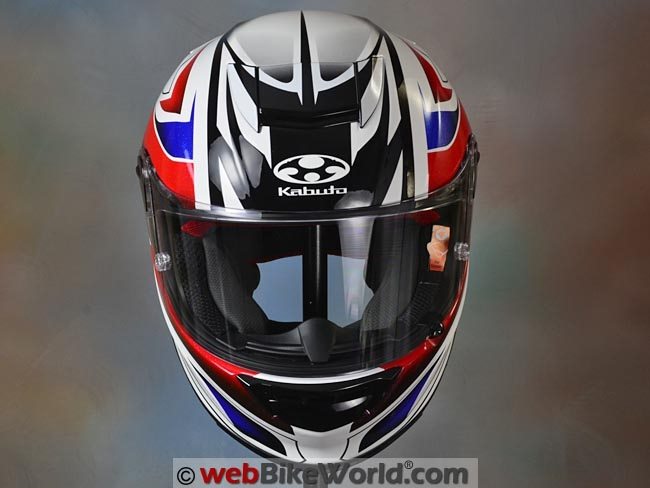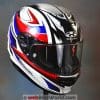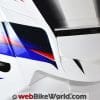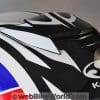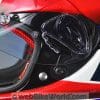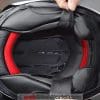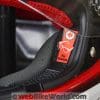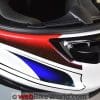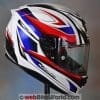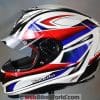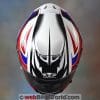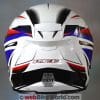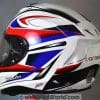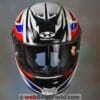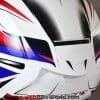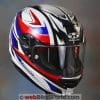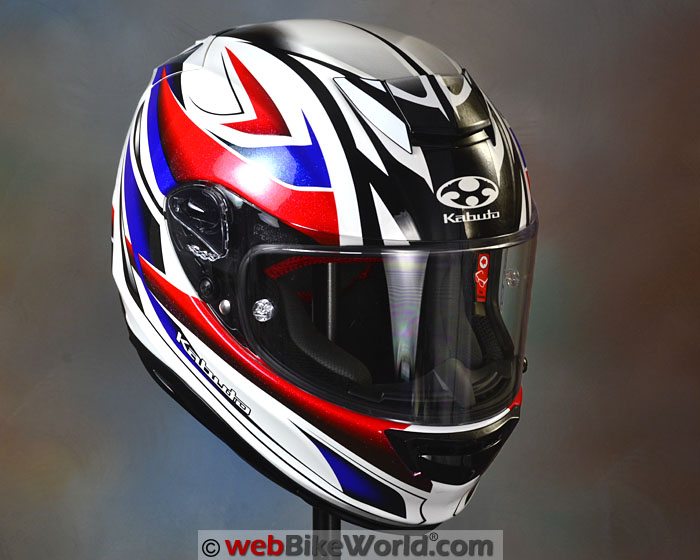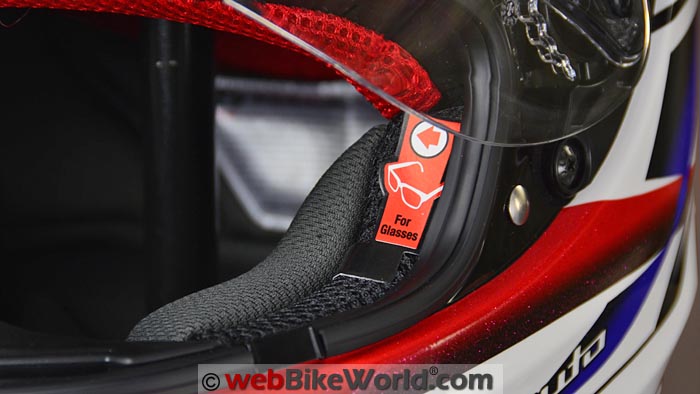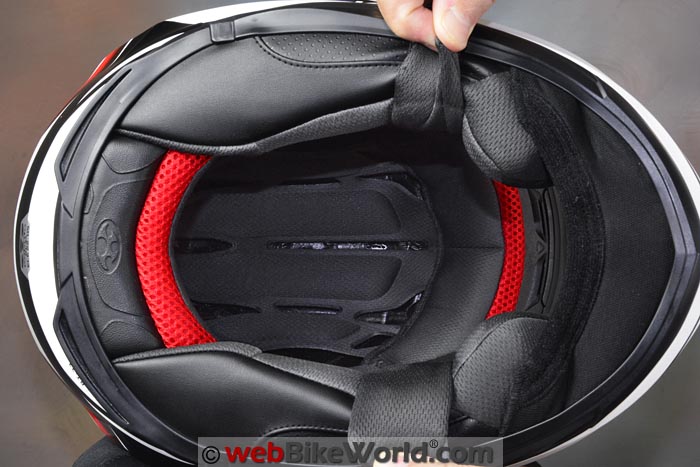The Kabuto RT33 is a relatively lightweight street/sport full-face helmet, brand new for 2015.
It splits the difference between the top-of-the-lineKabuto FF-5V (review) and the Kabuto Aeroblade III (review).
This gives Kabuto three very similar helmets in $50.00 price increments, starting at $349.95 for the Aeroblade.
One differentiator is that the RT33 meets DOT and ECE standards but is not Snell certified like the other two, which accounts for the lighter weight.
The helmet has the latest Kabuto/OGK upper ventilation system that we liked on the Kabuto Ibuki (review) and it provides a lot of air flow.
The RT33 also has generous padding and the eyeglass-friendly cheek pads.
It comes with a Pinlock insert and the face shield is Pinlock-ready but does not have the annoying molded indent surround found on some competitors.
The RT33 is a very nice helmet with a lot going for it, making a difficult but interesting choice between the three.
Background
Moving our way through the current Kabuto (formerly OGK) helmet lineup brings us to the brand new RT33.
The RT33 splits the difference between the current flagship helmet, the Kabuto FF-5V (review) and the Kabuto Aeroblade III (review).
That’s a pretty thin difference to slice, because all three of these Kabuto helmets are similar, all are very good helmets and all of this makes it very difficult to choose between the three.
That’s a nice problem to have!
After mulling it over, however, Burn and I would take the RT33 and save a few bucks over the FF-5V. The RT33 also has an efficient upper vent system that’s easier to use and its light weight is a plus.
The RT33’s vent system is the same type found on the Kabuto Ibuki flip-up helmet we reviewedpreviously.
The RT33 picks up an ECE rating in addition to DOT, which saves some weight over the Snell certification of the FF-5V and Aeroblade III.
The ECE rating means that apparently the RT33 sold in the U.S. is the same as the RT33 sold in Europe (despite some helmet manufacturer’s claims that it’s not possible to certify a single helmet for both).
For more information on the differences between helmet safety standards, please refer to these webBikeWorld reports:
- DOT vs. ECE Helmet Safety Standards
- The ECE 22.05 Motorcycle Helmet Safety Standard
- Snell M2015 Standard
The downside? The RT33 lists for $399.95 in solid colors and $449.95 in graphics.
Since the helmet is so new, it’s difficult to find on sale with a discount, while some older Shoei, Arai and Shark helmets that start with a higher list price can be had for around the same list price as the RT33.
That puts the RT33 in a tough spot, as the overall quality is excellent but it’s not quite at Shoei or Arai levels.
The Kabuto RT33: Paint, Graphics and Overall Quality
The RT33 has what Kabuto calls the “ACT EVO R” shell, a fiberglass composite either identical to or very similar to the fiberglass composite shell of the FF-5V, Aeroblade III and Ibuki flip-up.
The Kabuto Kamui (review), with its internal sun visor (and currently holding down fourth in the Kabuto lineup) has a composite polycarbonate shell.
The higher-end fiberglass composite shell of the RT33 and its higher-end stable mates helps to make up some of the $100.00+ price differential from the Kamui.
The RT33 has excellent build quality, with all of the moving parts and the liner having a good fit and feel. It seems to us to be very closely competitive with the HJC RPHA series, which are priced at around the same level.
You do get a Pinlock-ready face shield on the RT33 however, along with the insert included in the box, and that’s about a $50.00 value.
You also get a nicely padded, fully removable Coolmax liner that feels — for better or worse — very similar to some of the Arai offerings.
The RT33 has a very nice and relatively large owner-installed chin curtain (install with the foam on the inside!) and the excellent Kabuto upper ventilation system that brings in a lot of air with very little extra noise.
The red, white and blue “Rapid’ graphics shown here has a very nice and deep metalflake in the colors and the photos don’t do it justice.
The helmet is currently available in a limited color range however; solid colors include only matte black. A white or high-viz yellow or orange would be just the ticket for helmet happiness.
RT33 graphics include a black/white/silver or the red/white/blue “Rapid” graphics of our example and a very nice-looking black/orange/green “Veloce” graphic pattern.
Score: The Kabuto RT33 gets an “Excellent” rating from us for paint and overall quality. See the Summary Table at the bottom of the page for a description of our rating system.
Kabuto RT33 Fit, Sizing and Internal Shape
The Kabuto helmet size chart lists this RT33 in size large as a 59-60, but the label inside the helmet reads “58-59 cm”. The former is correct.
The internal shape is what we’d call very “Neutral” with a “Slightly Narrow” fit. It’s perhaps just a touch rounder than what seems to be the current standard of “Neutral” to “Slightly Narrow” that most helmet manufacturers have turned to over the past few years.
This shape should fit most head shapes other than the extremes at either end of the spectrum (see the webBikeWorld Motorcycle Helmet Shapes page).
The internal shape of the RT33 feels more “Neutral” than a typical Shoei.
Like the other Kabuto helmets we have reviewed recently, probably the closest similar fit comparison is the Arai RX-Q (review) and it’s our guess that the current crop of Kabuto helmets probably fits more head shapes with better comfort than just about any other brand.
Also like the other Kabuto helmets, the liner padding feels thick and comfortable. While the fabric on the RT33 liner isn’t quite as plush as a typical Shoei helmet, it does seem to do an excellent job at moisture wicking.
The RT33 ear pockets have a flat, lined bottom, good for mounting speakers. Most intercoms should fit the shell, with the intercom mount sliding between the outer shell and the EPS liner.
And again like the other Kabuto helmets, the RT33 has the “eyeglass friendly” cheek pad system, which helps to fit straight-temple eyeglasses or sunglasses.

Overall, we rate the Kabuto RT33 as very comfortable, especially for “Neutral” to “Slightly Narrow” head shapes
More information on helmet fit can be found in the webBikeWorld Motorcycle Helmet FAQ page, along with the chart that lists the helmet weights of webBikeWorld reviewed helmets and also by shape on the webBikeWorld Motorcycle Helmet Shapes page.
Score: The Kabuto RT33 gets an “Excellent” rating for comfort and liner materials and padding and a comfortable fit.
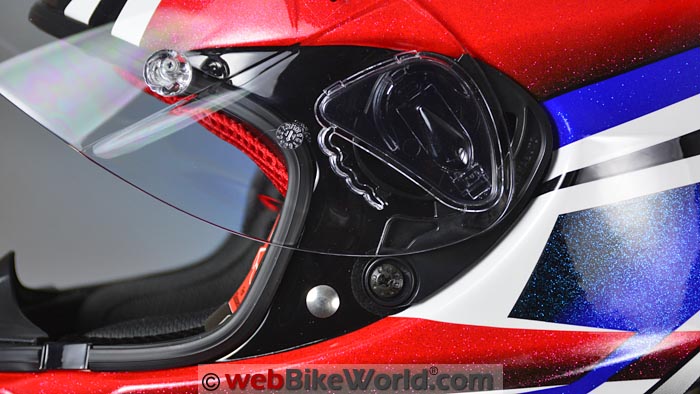
Kabuto RT33 Face Shield, Eye Port and Visibility
The RT33 uses the same type of face shield system found on the FF-5V and Aeroblade III. This means it has excellent visibility in both the vertical and horizontal planes.
The RT33 comes with Pinlock anti-fog insert (review) studs on the face shield and a Pinlock insert is included in the box.
The face shield thankfully does not have the molding on the inside to fit the Pinlock insert, so the view is not marred by the mold lines as it is on some recent helmets.
The face shield on this RT33 measures 2.11 mm thick. It also has a snap lock on the lower left-hand side to keep it firmly in place, again like the other top-end Kabuto full-face helmets.
There’s no small first opening position for city riding or defogging, but the face shield can be opened past the friction lock and left sitting on top, which does allow some air to enter.
It would be nice if Kabuto added a fourth detent for a dedicated city defogging position so the face shield can be “cracked” open just a touch and held in position.
Befitting its sport and track day purpose, the RT33’s face shield locks tightly in place when the snap is pushed and the full-surround eye port gasket also prevents any water from entering in our “leak down” test.
And the top and rear vents close tightly enough to prevent water from entering when riding in the rain.
The face shield removal system is similar to the FF-5V and Aeroblade III. Raise the shield, push in the button and the face shield slides out of a “U” shaped channel. To replace it, simply snap it back in (see the video below).
The optical quality of the face shield is very good and the RT33 does not have an internal sun visor.

Score: The Kabuto RT33 gets an “Excellent” rating for the overall quality and operation of the face shield.
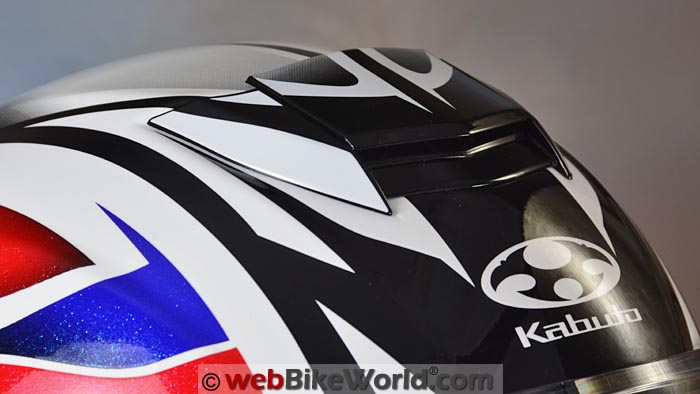
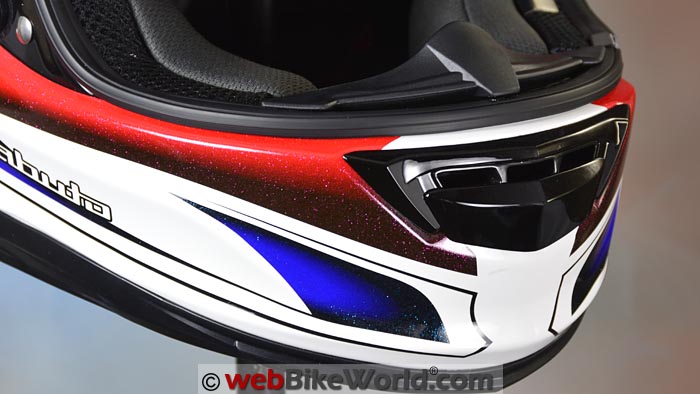
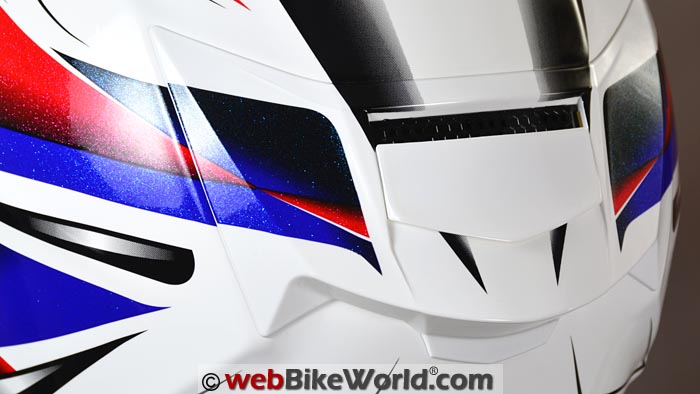
Ventilation and Air Flow
Helmets with the Kabuto name (and before that, OGK) have always had a reputation for outstanding ventilation and the RT33 is no different.
The RT33 has the same type of upper ventilation system as the Ibuki flip-up, with a single, wide slider in front and another in the rear.
This provides a plentiful amount of air intake and the exhaust is located more towards the top of the helmet, which pulls air through.
While the RT33 may not have quite the same ultimate volume of air flowing through as the Aeroblade III, it’s better than most full-face helmets and it does a good job at keeping the head cool in our current 32+ C (90+ F) humid weather.
The air volume doesn’t really raise the noise levels much, again like the other Kabuto full-face helmets.
There are a couple of big vent holes through the EPS that directly port the air through the front vent and the same in the rear, and this helps.
But, like the other Kabuto helmets, the chin vent on the RT33 isn’t quite as effective. There are no direct vents through the chin bar, something Kabuto should address.
Nevertheless, the air does flow up through the top of the chin bar and the owner-installed chin curtain helps.
So overall, the ventilation in the RT33 is better than average but perhaps not quite up to Aeroblade III standards.

Score: The Kabuto RT33 ventilation system rates an “Excellent” overall.
Kabuto RT33 Noise Levels
Again like the Aeroblade III, the RT33’s noise levels are relatively low, considering the good ventilation.
In fact, if it wasn’t for one issue, this might just be one of the quietest full-face helmets available today.
The problem area is with a gap at the lower rear of the RT33, just at the point where the cheek pads meet the rear of the helmet liner.
This area could use more padding, as noise leaks in through the back and can be heard as the air rushes through the space between the bottom of the helmet and the rider’s neck.
Both of us noticed this and the noise can be almost totally eliminated by holding a hand, finger or something in that area.
Kabuto should redesign the bottom of the liner to account for this, which could then make the RT33 exceptionally quiet.
As it is, the noise levels from the top half of the helmet are controlled better than average, with the lower half a little worse than average for an overall “Very Good” rating which, if fixed, could be “Outstanding”.

Note that our helmet evaluations are a combined effort of several riders over time on different types of motorcycles with and without windscreens.
Evaluators wear correctly fitted, high quality ear plugs (even when evaluating motorcycle intercom systems).
Always protect your hearing when riding a motorcycle. See the wBW Earplug Reviews for more information on choosing and wearing earplugs.
Note also that perceived noise levels will vary, depending on the individual.
Noise can be caused by many factors, including helmet fit, the type of motorcycle and windscreen, wind speed and direction and even the rider’s clothing.
For more information on helmet noise, visit the wBW Motorcycle Helmet Noise page.
Score: The Kabuto RT33 gets a “Very Good” rating overall for noise control.
Helmet Weight
This Kabuto RT33 in size L weighs 1519 grams (3 lbs., 5-1/2 oz.), which is very light for a full-face size large helmet.
The Aeroblade III weighed in at 1587 grams, so there’s a potential 68 grams weight savings (2.4 oz.) from not having the Snell certification.
For comparison, the HJC RPS-10 (review) in size large weighs 1525 grams; the Bell Star (review) in size large weighed 1559 grams and the Arai RX-Q (review) in size large weighed 1597 grams.
The RT33’s low weight puts it in the lightest 1/3 of the 250+ helmets we’ve reviewed so far on webBikeWorld.com.
Note also that all of the helmets reviewed on webBikeWorld have been weighed and the weights are available on the wBW Motorcycle Helmet Weights page, along with a chart that lists the helmets by weight and shape on the wBW Motorcycle Helmet Shapes page.
Score: The Kabuto Aeroblade III gets an “Outstanding” rating for its weight and good balance.
Miscellaneous
The RT33 has a double D-ring chin strap retainer with removable padding underneath. The padding could be longer but it’s acceptable.
Kabuto provides a five year warranty (from date of purchase) on their helmets and they have a discounted program for replacements if the helmet was in a crash.
wBW Opinionator: Kabuto RT33 Helmet
- Light weight.
- Relatively quiet.
- Nice styling.
- Comfortable liner.
- Water sealing.
- Noise from lower rear liner gap.
- Chin vent could be improved.
- Needs stronger first small detent.
- Short chin strap
- Thin chin strap padding.
Conclusion
Our conclusion in the Aeroblade III review was that it would be difficult to choose between that helmet and the FF-5V. The decision is now even more difficult with the RT33!
It comes down to some hair-splitting: if you’re looking for ultimate ventilation (and want to save about $50.00), the Aeroblade III is the way to go. For light weight, it’s the RT33.
The RT33 is our favorite of the bunch and will probably steal customers from the FF-5V. The RT33’s upper ventilation system is easier to use and the difference in weight is meaningful.
It would be nice if it was available at more of a discount, but that may come as the RT33 has been around longer.
The RT33 may not have any one specific revolutionary feature that differentiates it from the competition, but it does everything very well in a way that most helmets don’t, can’t or won’t.
Owner Comments and Feedback
See details on submitting comments.
From “D.S.” (September 2015): “In your article you implied the HJC RPHA did not come with a Pinlock insert, which made the Kabuto a better value.
Mine came with one. It also has a drop down sun shield with excellent visual quality that I use every time I ride and it comes in white!
Editor’s Note: The HJC RPHA ST has an internal sun visor but the RPHA 10 and RPHA 10 Pro do


